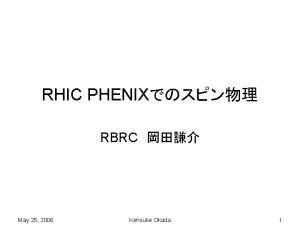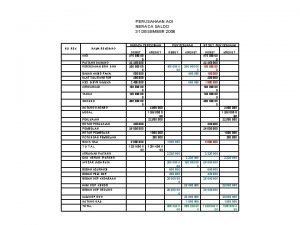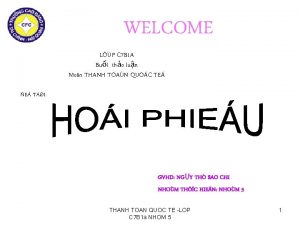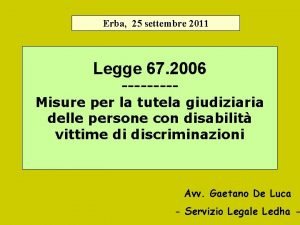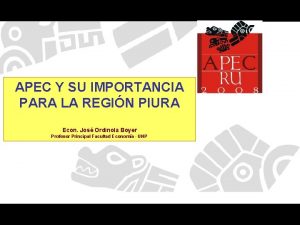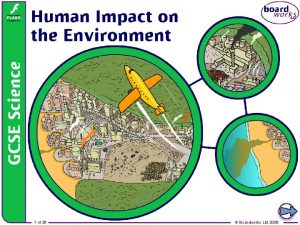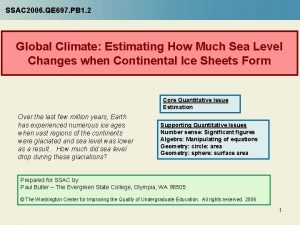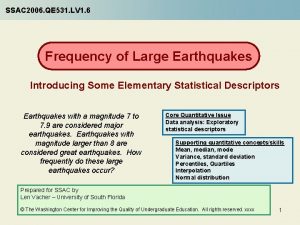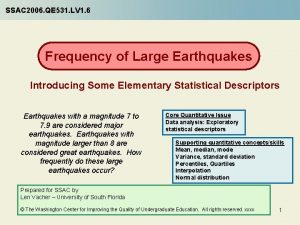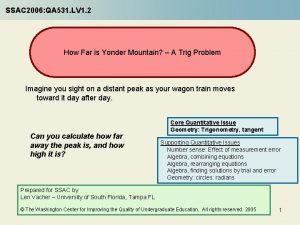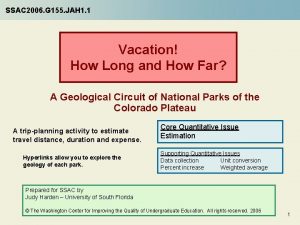SSAC 2006 DT 63 LV 1 3 How
















- Slides: 16

SSAC 2006: DT 63. LV 1. 3 How Large is the Great Pyramid of Giza? 1. , Would it make a wall that would enclose France? A back-of-the-envelope calculation by Napoleon in 1798 Core Quantitative Issue Estimation Supporting Quantitative Issues Unit conversions Significant figures Solid geometry: Volume of a pyramid Solid geometry: Volume to cross-sectional area Prepared for SSAC by Len Vacher – University of South Florida, Tampa © The Washington Center for Improving the Quality of Undergraduate Education. All rights reserved. 2006 1

Preview This module presents a calculation by Napoleon that puts into perspective the size of the Great Pyramid in Egypt. Slide 3 gives some historical background. Slide 4 states the problem. Napoleon had an answer. Was it correct? . Slides 5 and 6 analyze the problem and prompt you to design a plan to solve it. The problem breaks down to two parts. The first part (Slide 5) applies unit conversions and the formula for the volume of a pyramid. The second part (Slide 6) applies the relation between the cross-sectional area of a wall and the volume of the wall. The thinking of this second piece of the calculation is good to recall when you consider finding volumes by integration. Slides 7 and 8 create a spreadsheet that calculates an answer. Slides 9 and 10 discuss the mathematical point of the module and the historical context of the problem, respectively. Slide 11 consists of some questions that constitute your homework assignment. Slides 12 -15 are endnotes for elaboration and reference. 2

Background Quotation from p. 20, I. B. Cohen, The Triumph of Numbers, How Counting Shaped Modern Life, Norton, New York, 209 pp. , 2005. About Cohen and the Triumph of Numbers We begin by considering the numbers associated with the Great Pyramid of Gizeh in ancient Egypt, also known as the pyramid of Cheops or Khufu. This pyramid was constructed around 2500 B. C. E. , some 5, 000 years ago. Its size is enormous. The base is a square that covers a little more than 13 acres, an area large enough to contain side-by-side St. Peter’s of Rome and the cathedrals of Milan and Florence, together with Westminster Abbey and St. Paul’s Cathedral of London. The height is almost 500 feet, about the same as a building 40 stories high. Until the construction of the Eiffel Tower at the end of the nineteenth century, this pyramid was the tallest building in the world, a mammoth structure built of 2. 3 million stones, weighing from 2 to 15 tons each. The average weight of the stones is about 2. 5 tons, the same as the weight of a large family van or an old-time Cadillac limousine. For more about the Pyramid of Giza, complete with background music: http: //www. geocities. com/regkeith/rkeith 5 a. htm 3

Problem From p. 20, I. B. Cohen, The Triumph of Numbers, How Counting Shaped Modern Life, Norton, New York, 209 pp. During the Napoleonic campaign in Egypt in 1798, a famous battle was fought outside Cairo in Embaba, in view of the pyramids, and is known as the Battle of the Pyramids…. It is reported that, after the battle, Napoleon and his staff officers visited the Great Pyramid. While the more adventurous officers climbed to the top, Napoleon himself was content to rest in the shade of the pyramid at its base, toying with numbers. When the officers descended and rejoined him, Napoleon announced that he had made a calculation of the amount of stone in the pyramid. There was enough, he said, to build a stone wall 3 meters high and 0. 3 meter thick that would enclose the whole of France… Was Napoleon correct? Napoleon’s Egyptian campaign and 4 the Battle of the Pyramids

Designing a Plan, Part 1 What is the volume of a pyramid with a base of 13 acres and a height of 500 ft? You will need to convert • acres to sq meters • feet to meters You will also need to recall, figure out, or otherwise find out the formula for the volume of a pyramid. one-third area of base times height. Give answer in cubic meters. Note to geology students: Not many people recall the conversion of acres to square meters, but as geologists you should know that there are 640 acres in a square mile (why? ), just as easily as you know that there are 5280 ft in a mile and 3. 281 ft in a meter. You can get acres to m 2 from those. You can also determine the conversion of miles to kilometers; acres to hectares (1 ha = 104 m 2); and acre-ft to cubic meters. Actually, you don’t need the formula, as you will see in a second module on the Great Pyramid. 5

Designing a Plan, Part 2 You will need to strategize a way of finding the length of a wall if you are given its height, width, and volume. Note to geology students: Geologists come to think instinctively in terms of crosssections. So, what is the crosssectional area of a wall (i. e. , a transverse cross-section – perpendicular to the length of the wall)? What do you get if you divide the area of the wall into the volume of the wall, assuming that the wall keeps the same cross-section for its entire length? height width So what’s the plan? • Calculate the volume of the pyramid as 1/3 the basal area times the height. • Calculate the length of the wall as the volume divided by the height and width. • Estimate the perimeter of France. 6 • Compare the two lengths.

Carrying Out the Plan, 1: Spreadsheet to Calculate the Volume Cell with a number in it. Change one of these numbers and other numbers will change. Cell with equation in it. It’s up to you to determine the equation that produces the number that appears in the cell. Recreate this spreadsheet that calculates the volume of the pyramid. You will need your spreadsheet to do some of the End of Module Assignments. 7

Carrying Out the Plan, 2: Spreadsheet that Completes the Calculation Continue on with the calculation and complete the rest of the spreadsheet. Estimating the perimeter of France. More. 8

What you have done According to this rough calculation, Napoleon was correct: the Great Pyramid would make a wall that would stretch around the perimeter of France. This type of calculation is estimation – specifically, a back-of-the envelope calculation. The term was coined by Enrico Fermi for estimations that shed light quickly on the magnitude of a quantity. In concept, the calculations can be done on a sheet of paper the size of an envelope or cocktail napkin. Fermi, who was awarded the Nobel Prize in physics in 1938, worked on the Manhattan Project and was a pioneer researcher of beta radiation and one of the developers of quantum theory. He is well-known now in physics and mathematics education for Fermi problems where one makes order-of-magnitude calculations from reasonable estimates of other quantities. A classic example is “How many piano tuners are there in Chicago? ” Fermi’s work on the first chain reaction was beneath Stagg Field of the University of Chicago, where he returned to teach physics after the War. Back-of-the-envelope and Fermi problems General http: //en. wikipedia. org/wiki/Back-of-the-envelope_calculation http: //en. wikipedia. org/wiki/Enrico_Fermi In geoscience education http: //serc. carleton. edu/quantskills/methods/boe/index. html In engineering http: //cm. bell-labs. com/cm/cs/pearls/bote. html In physics http: //www. physics. umd. edu/perg/fermi. htm 9

A final quotation from The Triumph of Numbers (p. 23 -24) “The Great Pyramid was completed in about 20 years. Therefore, since 2, 300, 000* stones were set in place in 20 years, the number of stones must, on average, have been 2, 300, 000/20, or 115, 000 stones per year. The laborers presumably worked every day without a day off, 365 days a year. Thus, the average number of stones put in place in a single day must have been at least 115, 000/365, or 315 stones. Assuming that the laborers would have worked on average some 10 hours each day, we can calculate that the number of stones set in each hour must have been 315/10, or about 30. In other words, simple arithmetic applied to the numbers shows that the building of the pyramid must have involved setting 30 stones in place, on average, in every hour of the working day. This conclusion can be stated simply as follows: a giant stone was put into the structure every two minutes. How could this have been done? ” For the answer, get the book. Finish the first chapter. Then continue to the end. * Cohen’s footnote: “These numbers give a correct order of magnitude but there are two reasons why we cannot say exactly how many stones are present in the pyramid. One is that there are some empty spaces in the interior burial chambers, chapels, etc. The second is that some of the interior space would have been filled with rubble. ” 10

End of Module Assignments 1. Actually, the Great Pyramid is 146 m high, and the area of its base is 13. 1 acres. Turn in a copy of a spreadsheet using these values for the starting measurements. 2. What is the edge length of the square at the base of the Great Pyramid in feet? 3. Some high school football fields are surrounded by a quarter-mile track. How many of these tracks would fit inside the pyramid? 4. Work out the conversion factors between hectares and acres – • How many hectares are in one acre? • How many acres are in one hectare? 5. What is the volume of the Great Pyramid in acre-ft? An acre-foot is a common measure of water volume. It is equivalent to a one-acre area covered with a layer of water one foot deep. 6. If the volume of the Great Pyramid is what you say it is, and the volume is equal to the sum of 2. 3 million blocks (Cohen), how much would each block weigh? What else do you need to assume to do the calculation? 11

I B Cohen and The Triumph of Numbers From the book jacket, quoting Chapter 1: We live in a world of numbers. Some of these numbers lie hidden from us in the operations of government, the conduct of business and finance, the activities of science and engineering, and even in daily life. Other numbers command our attention in the fluctuating price of gasoline and our monthly bank balances and credit-card statements. We encounter numbers in newspaper headlines and TV newscasts – CLI, GNP, the Dow (or Dow Jones) and Nasdaq. Sports fans discuss ‘stats’ such as RBI; headlines declare the size of the national debt or the annual federal budget. A mysterious numerical quantity called APR appears on our monthly credit-card statements…. When did this invasion of numbers begin? From the book jacket, on I. B. Cohen : Perhaps the most influential American figure in the rise of the history of science as a scholarly discipline, I. B. Cohen (1914 -2003) established the history of science department at Harvard University and held an endowed chair in that department. He is the author of many books, including Science and the Founding Fathers, a seminal translation of Newton’s Principia, and The Birth of a New Physics. The Triumph of Numbers was Cohen’s last book (2005). On his death in 2003: http: //www. hno. harvard. edu/gazette/2003/07. 17/09 -cohen. html Return to Slide 3 12

Napoleon in Egypt See Discovery Channel’s http: //www. exn. ca/napoleon/egypt. cfm Return to Slide 4 From the Website See also: Gillispie, The Scientific Importance of Napoleon’s Egyptian Campaign, Scientific American, September 1994: http: //www. sciamdigital. com/index. cfm? fa=Products. View. Issue. Preview&ART ICLEID_CHAR=4792870 E-CA 63 -43 A 4 -933 B-5 DB 937 FA 4 ED 13

Why geologists know there are 640 acres in a square mile The US Public Land Survey System. A township is divided into 36 numbered sections, Each is a square one mile on a side (with occasional deviations). Each section contains 640 acres. Sections are parceled into quarters (160 acres), halves of quarters (80 acres) and quarters of quarters (40 acres). Return to Slide 5 Sections in a township Parcels in a section Figures are from http: //www. outfitters. com/genealogy/land/twprangemap. html which provides explanations. For description, history and more about the Public Land Survey System, see 14 http: //nationalatlas. gov/articles/boundaries/a_plss. html

Perimeter of France From The Triumph of Numbers, p. 22. Reims Besançon Montpelier http: //geography. about. com/library/cia/blcfrance. htm “France has roughly the shape of a rectangle, almost a square, a little longer from north to south (approximately 770 km, as measured from Montpelier to Rheims) than from east to west (approximately 700 km, as measured from Nantes to Basançon)” Return to Slide 8 15

Pre-Test • How many acres are in a square mile? • What is the volume of a pyramid that has a base of 30 acres and a height of 300 ft? Give answer in acre-ft. • What is the volume of a cone that has a base of 30 acres and a height of 300 ft? Give answer in acre-ft. • A snake has a volume of 30 cm 3. Its cross-sectional area is 1 square cm. How long is the snake? Give answer in inches. • How long would it take you to walk from campus to the intersection of Kennedy and Westshore? Give answer in minutes, and explain how you got it. • Suppose the Geoclub wanted to fill this lecture room with balloons. How many balloons would it take? Explain your answer. 16
 Icann
Icann May 25 2006
May 25 2006 2006
2006 31 desember 2006
31 desember 2006 Adler and rodman 2006
Adler and rodman 2006 T.trimpe 2006 http sciencespot.net
T.trimpe 2006 http sciencespot.net 6/4/2006
6/4/2006 Http sciencespot net
Http sciencespot net Rose report 2006
Rose report 2006 4 teras utama misi nasional 2006 hingga 2020
4 teras utama misi nasional 2006 hingga 2020 Copyright 2006
Copyright 2006 Moon on 1/7/2006
Moon on 1/7/2006 Legge 67 2006
Legge 67 2006 Importancia del apec
Importancia del apec Monarch awards 2006
Monarch awards 2006 Boardworks ltd 2006
Boardworks ltd 2006 T. trimpe 2006 http://sciencespot.net/
T. trimpe 2006 http://sciencespot.net/

